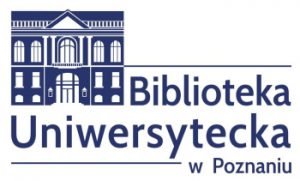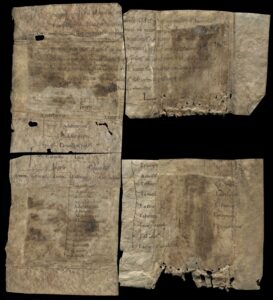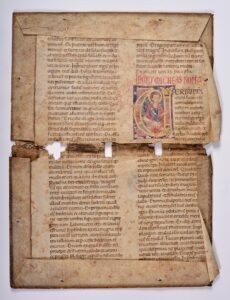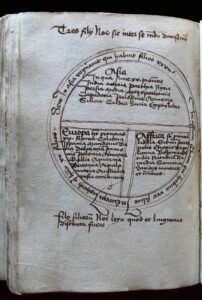Special Collections Department
Room 174; tel. 61 829 3827
Monday | 9.00 am.-3.00 pm. |
Thuesday, Thursday, Friday | 9.00 am.-3.00 pm |
Wednesday | 9.00 am.-6.00 pm. |
Staff:
dr Alicja Szulc, kustosz dypl.
tel. 61 829 3827
MANUSCRIPT COLLECTION AT POZNAŃ UNIVERSITY LIBRARY
The collection of manuscripts at Poznań University Library currently numbers over 8,000 units (as of 2020) representing diverse chronological range spanning the thirteenth century up to the 2020s. The collection includes a large number of unique relics of exceptional research value, mainly of local provenience. The diversity of the collection, which not only represents a wide range of geographic locations, but also the full spectrum of available materials of primarily Polish and German art, culture, and history, is a result of the tangled and intricate history of the Library, beginning with its foundation as the Kaiser-Wilhelm-Bibliothek in 1901, through the renaming of the Library into the Library of Poznań University in 1919 and the subsequent Polonisation of its holdings during the inter-war period, then its operation as the German Staats- und Universitätsbibliothek between 1939 and 945, to the operation of safeguarding and protecting book collections that survived WWII (1945-1950).
The oldest part of the collection features 46 medieval codices – predominantly of local provenience. The oldest of the codices, including treatises on the sacraments and liturgical rites and instruction, originated in Southern Europe in the first half of the thirteenth century. The remaining codices come mainly from the fifteenth century and the first half of the sixteenth century.
A large part of the collection is composed of miscellanea, i.e. codices that include copies of texts of different authors on a variety of subjects and in a number of forms. One of them is a hand-written text of the Gniezno canon Jakub of Kowalewice from 1478 that contains a unique cartographic relic – the mappa mundi by Isidore of Seville – one of the oldest surviving world maps in manuscript collections in Poland.
The collection of 46 mediaeval codices has been digitised and is available via Wielkopolska Biblioteka Cyfrowa [Wielkopolska Digital Library]. The collection has been made available as part of the National Library Resources since 2016.
In the Medieval past, sections of manuscripts, written on parchment or vellum, were commonly re-used by medieval binders to produce bindings and end leaves of other books. These particular book relics in the collection include the following:
- a section of a page from an eleven century copy of the treatise De topicis differentiis by Boetius, preserved in four parchment strips (about 4 x 3 cm), previously used in the binding of an unidentified codex.
- illuminated leaf of a Romanesque Bible from the 12th./13th c. – the only surviving fragment of the so-called ”Atlantic Bible” in Poland. On account of its large-scale design, this generic name is attributed by researchers to a particular type of illuminated Bibles produced in monastery scriptoria in central Italy until the end of the eleventh century. A large manuscript parchment leaf (56,5 x 39 cm), made of sheep skin and embellished by two figurative initials, was used as a binding of a book
- the so-called ”fragment of the Manuscript of St. Clare in Stary Sącz” – a small piece of parchment (9 x 4,9 cm) from the end leaf of a gradual from the St. Clare in Stary Sącz, that includes a thirteenth century musical repertoire attributed to circles of the Notre-Dame school of polyphony
- document (littera exsecutoria) issued by Pope Innocent VII from 1404 to Bishop of Prague. The document concerns the Cistercian abbey in the town of Nepomuk near Pilsen, and having been split into two parts was also used as a bookbinding material. This particular relic is a treasure trove of history and a primary source material on the abbey, as the archives of the abbey were dispersed in the fifteenth and the sixteenth centuries.
Another important sub-category of the collection comprises manuscripts from the libraries and archives that once belonged to the landed gentry of the region and were subsequently taken over as a result of the post-war operation of consolidation of abandoned and dispersed book collections that had survived the war. In this way, Poznań University Library obtained parts of the book collection and archives of the Skórzewski family of Czerniejewo-Radomice and Lubostroń (including 7 catalogues of the Lubostroń library, among others), the Mielżyński family from Pawłowice and Chobienice, the Mycielski family of Kobylepole, the Kościelski family of Miłosław and the Żółtowski family of Niechanów, the Pawłowski family of Grudzielec, the Radoliński family from Jarocin and the Trąmpczyński family of Dębłów near Gniezno. This group of book collections include a particularly interesting and highly valuable as source material 3-volume travel journals written by the French priest Claude Antoine Pochard, tutor to the Skórzewski family between 1792 and 1833, describing his visits to different countries in Europe and to Poland.
Between 1945 and 1950, parts of the libraries formerly belonging to German landowning families from Greater Poland were added to the Library. These include book collections of the von Massenbach family of Białokosz (including the catalogue of the family library from 1888), the Stolberg-Wernigerode family of Borzęciczki near Krotoszyn, the Maltzan famly of Milicz (including some sections of a particularly valuable collection of music manuscripts of the repertoire for the Milicz courtly Kapelle), and the collection of Baron Joachim von Loesch from Jabłonna near Rydzyna, among others. The German collection is supplemented by some archives and book collections of the Baltic Germans as well as parts of the archives and Freemason collections from all Europe appropriated on Himmler’s orders during WWII. Manuscripts from Freemason lodges, mostly membership registers of individual lodges from the eighteenth to the twentieth centuries have been sectioned off from the Manuscript Division and constitute a separate category in the resources of manuscripts of the Library.
From the 1950s onwards, the collection of the archives of the local landowning gentry has been constantly and consistently expanded through purchases or donations. The new acquisitions include: part of the family archive of the Czartoryski family of Siedlec, Rokosowo and Sarbinowo, the families of Dąbrowski, Mańkowski, Chłapowski and Turno of Objezierze, Morawski of Oporow, Stablewski of Antoninek and Zalesie, as well as those of the Odrowąż-Pieniążek family and the family of Rościszewski.
Archives of institutions, associations and societies, both Polish and German and mainly from the area of Greater Poland, form another group of manuscripts. The largest include the archives of the Historische Gesellschaft für die Provinz Posen (1885-1945) and the Historische Gesellschaft in Polen (1919-1939), the records of the Polish Writers’ Union, Poznań branch, from the years 1921-1933) and the archives of the Polish School Museum in Lwów. In addition, the library collection includes archival material of the following associations and societies: the Society for the Support of Youth in the Grand Duchy of Poznań (1842-1845), the Pedagogical Society in Trzemeszno (1856-1858), the Posener Provinziallehrerverein (files and records from 1771-1896), the Hindenburg-Museum (files and records from 1917-1921), the National Women’ Organisation in Poznań (1924-1927), the Polish-Italian Society in Poznań (1932-1934) and many others.
A separate category of the manuscripts in the Library is formed by the so-called heritage collections, or sections thereof, of well-known social activists and politicians: August Cieszkowski, Jan Rymarkiewicz, the priest, Antoni Stychel, Józef Morawski, Cecylia Działyńska and others); men of letters: Emil Zegadłowicz and Stefan Borsukiewicz; composers, musicians and musicologists: Adolfa Chybiński, Bolesław Dembiński, Feliks Nowowiejski, Stefan Poradowski, Andrzej Koszewski, Jerzy Młodziejowski, Kornel Michałowski, Maria Szczepańska and others), and professors and scholars of Poznań-based universities: Adam Skałkowski, Roman Pollak, Stefan Różycki, Adam Wrzosek, Jan Czekanowski, Karol M. Pospieszalski, Edward Taylor or Zbigniew Zakrzewski, as well as many others who have contributed to the culture, science and research of the region. This particular group of manuscripts was enlarged by the heritage collections (i.e. collections of works of art, books and records that belonged to and are related to one particular artist) of two local artists acquired by the Library between 2010 and 2012: Henryk Derwich (1921-1983), a Poznań-based cartoonists associated with the local daily newspaper Express Poznański and Wacław Taranczewski (1903-1987), the artist who decorated churches in Poznań and the region and remodeled old structures, particularly commercial buildings and public edifices.
A large part of the manuscript collection is composed of collections of memoirs and written down recollections, mainly from the WWII, of the actual participants or eye-witnesses. The largest collection (200+) is that of the memoirs of the participants of the Greater Poland uprising of 1918–1919 (notably those of Roman Wilkanowicz, Ignacy Andrzejewski, Stanisław Nogaj, Wacław Noskowiak, Kazimierz Skrzydlewski and Antoni Henke) and memoirs and written down recollections from the time of the German occupation, 1939-1945 (nearly 1,800), students of the Law Faculty and Economy at the Poznań University, Academy of Commerce in Poznań and the Academy of Commerce in Szczecin.
Yet another group of manuscripts in the manuscript collection is the collection of friendship books (Latin: alba amicorum) that include personal notes, such as a handwritten greetings, poems (typically, of one’s own composition) or other small literary texts. Consistently developed through purchases and donations, the collection now amounts to 84 friendship books from the seventeenth to twentieth century (as of 2020). On account of personal entries and inscriptions of many well-known artists, writers or politicians, the book of friends that once belonged to the novelist and memorialist Paulina Wilkońska, née Laucz (1815-1875) is considered to be the most valuable in the collection. Her ”album” includes entries and small pieces of compositions by Edward Dembowski, Stanisław Jachowicz, Karol Libelt, Stanisław Moniuszko, Teofil Lenartowicz and August Bielowski, among others. A friendship book that belonged to Krystyna Szyszłło includes, in turn, entries made by members of aristocracy, artists, writers and politicians from the years 1900-1925, such as Henryk Sienkiewicz, Ignacy Jan Paderewski, Artur Oppman, Wojciech Kossak and Kazimierz Alchimowicz.
The card catalogue of manuscripts is also available online
The card catalogue of manuscripts is also available online on the Library’s web page in two sections: ”Manuscripts" and ”Manuscripts: index of catalogued manuscripts"
Bibliography
Basic references
M. Szymańska, Katalog rękopisów Biblioteki Głównej Uniwersytetu im. A. Mickiewicza w Poznaniu. Rękopisy XVII i XVIII wieku. Sygnatury 400 – 699, Poznań 1971
Z. Pietraszek, Katalog Rękopisów Biblioteki Uniwersyteckiej w Poznaniu. Spuścizny naukowe XX wieku. Sygnatury 700-749, Poznań 1985
Z. Pietraszek, Poznań – Biblioteka Główna Uniwersytetu im. Adama Mickiewicza, w: Zbiory rękopisów w bibliotekach i muzeach w Polsce. Oprac. D. Kamolowa przy współudziale K. Muszyńskiej. Warszawa 1988, s. 191-202
A. Szulc, D. Kolbuszewska, Zbiory specjalne Biblioteki Uniwersyteckiej w Poznaniu: rękopisy [Informator], Poznań 2015
A selection of monographic articles
H. Kowalewicz, Rękopiśmienny kalendarz poznański z XV wieku, „Biblioteka” 4 (1964), s. 35-53
H. Kowalewicz, Średniowieczne zabytki języka polskiego w zbiorach Biblioteki Uniwersyteckiej w Poznaniu. Polskie glosy i zapiski z rękopisów 1728, 1732, 1752, „Biblioteka” 5 (1965), s. 69-121
H. Kowalewicz, Średniowieczne zabytki języka polskiego w zbiorach Biblioteki Uniwersyteckiej w Poznaniu. Cz. II: Polskie glosy z rękopisów 1725, 1740, „Biblioteka” 7 (1968), s. 50-63
U. Puckalanka, Nieznana mapka świata w polskim rękopisie XV wieku, „Studia i materiały do dziejów nauki polskiej”, 1968, seria C, z. 13, s. 3-10
G. Chmielewski, Iluminowana karta Biblii „atlantyckiej”, „Zielonogórskie Zeszyty Muzealne” t. 1(1969), s. 205-210
A. F. Majewicz, A Batak (?) manuscript in the Poznań University Library (Communique and query), in: Pan-Asiatic Linguistics. Proceedings of the Third International Symposium on Language and Linguistics, ed. Sudaporn Luksaneeyanawin et al., Bangkok: Chulalungkorn Univeristy, 1992, p. 657-664
M. Matczak, Bohemica w zbiorach sekcji rękopisów Biblioteki Uniwersyteckiej w Poznaniu, „Roczniki Biblioteczne” 39(1995), z.1/2, s. 139-142
M. Jagielska, Rysunki uczniów poznańskich szkół z 1911 i 1913 roku w zbiorach Biblioteki Uniwersyteckiej w Poznaniu, „Biblioteka” 2003, nr 7, s. 59-68
A. Szulc, Codex collecticius Jakuba z Kowalewic. Ze zbiorów Biblioteki Uniwersyteckiej w Poznaniu, „Ecclesia. Studia z dziejów Wielkopolski” 4(2009), s. 409-418. DOI: https://doi.org/10.14746/e.2009.4.12
A. Szulc, Średniowieczne kodeksy rękopiśmienne w zbiorach Biblioteki Uniwersyteckiej w Poznaniu, w: Zbiory specjalne i regionalia w polskich bibliotekach naukowych i publicznych, red. R. Gaziński, Szczecin 2010, s. 149-155
R. Wilgosiewicz-Skutecka, Odkurzanie pamięci – pamiętniki uczestników Powstania Wielkopolskiego 1918-1919 w Wielkopolskiej Bibliotece Cyfrowej, w: Zbiory specjalne i regionalia w polskich bibliotekach naukowych i publicznych, red. R. Gaziński, Szczecin 2010, s. 223-228
R. Wilgosiewicz-Skutecka, Polska w oczach guwernera Skórzewskich, czyli zapiski księdza Pocharda z lat 1792–1833 w zbiorach Biblioteki Uniwersyteckiej w Poznaniu, „Biblioteka” 15 (2011), s. 9-24. Dostępny w Internecie: http://hdl.handle.net/10593/1777
A. Szulc, Bohemica w zbiorach rękopisów Biblioteki Uniwersyteckiej w Poznaniu, w: Na styku kultury polskiej i czeskiej. Dziedzictwo, kontynuacje, inspiracje, red. M. Balowski, Poznań 2011, s. 287-293
A. Szulc, Kodeks magistra Hieronima Szwarca. Przyczynek do dziejów najstarszego księgozbioru bernardynów w Krakowie, „Biblioteka” 2014, t. 18, s. 219-233. DOI: 10.14746/b.2014.18.10
A. Szulc, Ukryte w okładce. O odnalezionym dokumencie Innocentego VII z 1404 roku i opactwie cysterskim w Pomuku, „Biblioteka” 20(2016), s. 7-21. DOI 10.14746/b.2016.20.1
A. Szulc, Czternastowieczny kodeks Antonio da Rido ze zbiorów Biblioteki Uniwersyteckiej w Poznaniu (Rkp. 1736). Analiza treściowa i proweniencyjna, w: Textus et pictura. Średniowieczny kodeks rękopiśmienny jako nośnik treści, znaczeń i wartości artystycznych, red. M. Jakubek-Raczkowska, M. Czyżak, Toruń 2019, s. 117-128.








